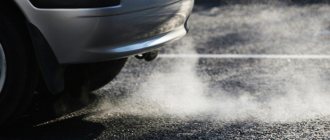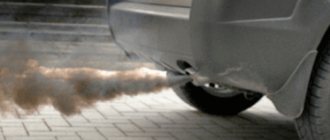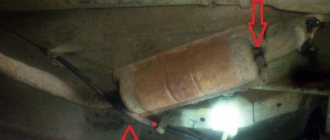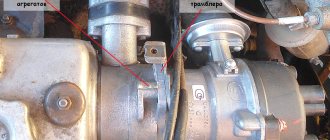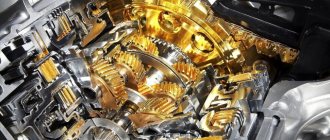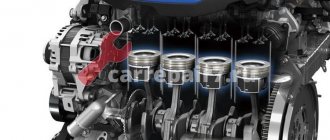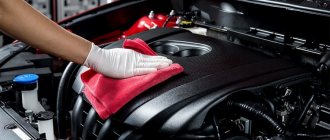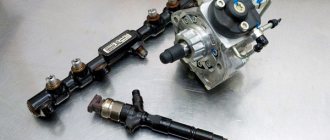This material will discuss the possible causes of white smoke from the exhaust pipe, which in most cases indicate the presence of malfunctions in the internal combustion engine systems. Normal combustion of the fuel-air mixture on a warm engine should occur without pronounced smoke, indicating the presence of foreign combustion products in the exhaust gases.
Author: Raul_ HF and wheel alignment mechanic; experience – 3 years. Service/repair consultant at Toyota DC; experience – 4 years.
White smoke when the engine is running properly
In conditions of high air humidity and in the cold season, condensation forms on the walls of the exhaust system circuit. When the engine is running, the muffler heats up, and moisture evaporates, mixes with the exhaust gases, and white smoke comes out of the pipe. This continues until all the condensation formed in the muffler has evaporated. To do this, it may not be enough to warm up the engine to operating temperature, and you may need to drive several tens of kilometers.
However, this is not smoke, but water vapor, and it quickly dissipates into the air. You may also notice drops of water at the end of the exhaust pipe. If the exhaust tract at the outlet is completely dry, and smoke from engine operation hangs like a cloud or fog, this indicates a problem and the need to diagnose the engine.
The main cause of white smoke from the exhaust pipe is condensation.
White smoke is more likely to be steam, because it does not have a special odor and is similar to a sign of a large amount of water boiling profusely. In fact, this phenomenon is most often caused by the accumulation of condensate in the exhaust system pipes and in the engine itself. This kind of steam release occurs especially often in winter, when the car is cooling down in the cold or in a cold garage.
After starting the engine, you will notice thick white steam from the exhaust pipe, but after a few minutes of warming up the power unit, this phenomenon will disappear. The mechanism for the appearance of such steam is quite simple:
- when traveling by car, all mechanisms warm up quite strongly;
- as soon as the car is turned off and put in the garage, the car begins to cool down;
- Given the sub-zero temperature around, condensation begins to accumulate on warm parts;
- when the engine starts, the exhaust system and the power unit itself quickly heat up;
- The condensate quickly boils away and exits through the pipe in the form of thick steam.
Also, in this situation, a small amount of steam may appear from under the car and even under the hood. After operation, the engine has a high temperature not only inside, but also outside, so condensation also accumulates on the surface of the unit.
Do not worry in this case - we are not talking about a broken exhaust pipe or any problems with the engine. You just need to wait for all the condensation to evaporate and continue to operate the car calmly. If you want to avoid such situations, purchase a heated garage.
What can the exhaust color say?
Based on the color of the exhaust gases, we can draw conclusions about the following violations in the operation of the engine:
- black exhaust – a combustible mixture over-enriched in fuel;
- blue exhaust – oil entering the combustion chamber;
- white exhaust means coolant has entered the cylinders.
One of the reasons for black exhaust is a too rich fuel mixture. An excess of fuel enters the cylinders, and it does not have time to completely burn during the engine cycle. Unburnt fuel products are emitted through the exhaust pipe in the form of soot particles. The causes of the problem may lie in both the injection system and the ignition system.
Often, an over-enriched combustible mixture is the result of severe contamination of the air filter, which leads to a significant lack of air for combustion. Perhaps the malfunction is due to incorrect operation of the nozzles or injectors and is associated with ineffective atomization of the mixture or “overfilling” of fuel. Often black exhaust smoke is accompanied by unstable engine operation and loss of power.
The uncharacteristic bluish or white color of the exhaust gases indicates the presence in the cylinders of those components that ensure the functioning of the engine, but under normal conditions remain isolated and do not participate in the combustion processes of the fuel mixture. This becomes possible if the tightness of one of the engine circuits - oil or cooling - is broken.
When foreign liquid enters the engine cylinders, its combustion products also give the exhaust gases a corresponding color. For example, the loss of engine oil is accompanied by a blue exhaust, and thick white smoke from the chimney is the result of coolant entering the combustion chamber.
White exhaust on a gasoline car
White smoke from the exhaust pipe of a gasoline engine is a sign of the presence of a large amount of moisture in the combustion products. This can be observed even on a working engine in the following cases:
- in conditions of high air humidity, or in rainy weather;
- in winter, at temperatures below -10C, on a cold engine;
- at extremely low temperatures (below -25C) even with the engine warmed up to operating temperature.
The above reasons why white smoke comes from the exhaust pipe are explained by a simple temperature difference and increased vapor formation under certain weather conditions and air temperature. The exhaust is quite dense, but quickly dissolves, since it consists mostly of water vapor.
If the car is used for short trips, this phenomenon can be observed constantly, since all the moisture does not have time to evaporate completely during the short time the engine is running. You may even notice water flowing out of the exhaust pipe when accelerating or spray flying when the engine is running. It should be borne in mind that in this mode of operation of the car, the constant presence of water in the exhaust pipe will lead to its premature destruction by corrosion.
The formation of a dense white exhaust that hangs in the air for a long time at the exit of a warm engine is a sure sign that coolant, which is half water, has entered the combustion chamber. When the engine is running, the exhaust smoke becomes white, indicating that foreign components are burning together with the fuel. Its density is such that it resembles a smoke screen and completely blocks visibility.
Why is there white smoke coming from the muffler?
Why is there black smoke coming from the muffler?
Every car owner should understand a simple truth - correct and high-quality operation of the power unit is the key to successful operation of the car and saving costs on fuel and repairs. If the motor starts to work intermittently or in abnormal mode, this needs to be corrected urgently; further use of the machine with breakdowns can lead to major breakdowns and additional repair costs. Therefore, it is necessary to monitor the serviceability of all components of the car, and timely replacement of faulty ones is the priority task of the car owner. Therefore, if black smoke begins to come from the exhaust pipe of a vehicle, then it is necessary to understand and eliminate the cause as soon as possible. In some cases, the problem can be solved quite quickly and easily, even at home. First of all, black exhaust gases indicate a violation of the quality of the fuel mixture. This is a sign that the fuel may not burn out completely due to an excess, or foreign substances not intended for the fuel system enter the combustion chamber. In fact, black smoke from a car's exhaust system can occur due to many reasons. But in this article, we will try to deal with most of them and try to talk about methods for correcting these breakdowns. (adsbygoogle = window.adsbygoogle || []).push({}); We also suggest that you read similar articles that will help you understand the reasons for different colors of exhaust gas: blue smoke from the muffler and why white smoke comes from the muffler. Why does exhaust gas appear black? As mentioned above, the main reason for the appearance of black smoke is incomplete combustion of the fuel mixture in the engine, but there are many reasons for this. The color of the smoke appears due to particles of unburnt fuel, which become charred with soot and fly out along with the exhaust gases, polluting the entire system and disrupting the normal operation of the engine. It is worth mentioning that the presence of black smoke during start-up and warm-up is normal for diesel cars and there is no need to worry. In other cases, this is a sign of a breakdown that requires prompt correction. And so, the main reasons influencing the appearance of black smoke are described below in the list: the simplest is the low quality of the poured fuel, which cannot burn completely and is discharged along with the exhaust gases; • malfunctions in the fuel supply system, in which gasoline or diesel fuel flows in uncontrolled doses; • The nozzles spraying the fuel are very dirty, so the liquid is supplied in a stream or drops, which does not allow time for complete combustion; • The fuel contains many additives that are not suitable for your engine type; • The fuel supply control sensor has failed, so fuel is supplied in uncontrolled portions; • a rare but possible cause is depressurization of the engine block or uncontrolled air intake. Some signs and consequences of problems may be expressed as follows: It is likely that fuel consumption has increased significantly, and the emission of harmful substances through the exhaust system has become stronger; problems begin with starting the engine, the car begins to lose its power and agility, and the engine itself begins to work unstably. In rare cases, this effect occurs from severe wear of the engine pistons and cylinders, which leads to very large emissions of black exhaust gas. In this case, operating the car becomes almost impossible, due to severe discomfort for the driver, passengers and other road users. (adsbygoogle = window.adsbygoogle || []).push({}); If the symptoms described above appear, you should immediately seek help from a car service station. Continued use of the machine may lead to even greater damage. How to independently deal with the causes of black smoke In some cases, solving the problem is very difficult, especially with physical breakdowns in the engine mechanics, but more often than not, these are the consequences of the car owner’s inattention or laziness. If you continue to use the car for a long time with more than the listed problems, you can cause irreparable damage to the car or end up with expensive repairs. Therefore, below is a list of actions that will help get rid of or understand the cause of black smoke: • First of all. It is necessary to fill the tank with known high-quality fuel, and it is advisable to drain the remains of the previous one. After this, you can evaluate the quality and intensity of exhaust gases; • Also, it is worth checking or immediately changing the fuel filter; • The next step is to check or replace the engine air filter to avoid airborne contaminants; • With some skills and knowledge of the design of modern cars. You can independently check the operation of the injection system and the operation of the injectors; • It is worth noting that in the case of a diesel unit, the most common cause is contamination of the injectors, so have them cleaned immediately (this will not make things worse); • To be on the safe side, you can measure the compression in each cylinder and compare it with the nominal pressure tolerances for your car; (function(w, d, n, s, t) { w[n] = w[n] || []; w[n].push(function() { Ya.Context.AdvManager.render({ blockId: "RA-149162-3", renderTo: "yandex_rtb_R-A-149162-3", horizontalAlign: true, async: true }); }); t = d.getElementsByTagName("script")[0]; s = d .createElement("script"); s.type = "text/javascript"; s.src = "//an.yandex.ru/system/context.js"; s.async = true; t.parentNode.insertBefore( s, t); })(this, this.document, "yandexContextAsyncCallbacks"); But unfortunately, there are several dozen causes of malfunctions, and it is impossible to check all of them at home. But the above provides a full range of measures to help solve the most common causes, which can be solved independently at home. Otherwise, contacting a mechanic at a car service station cannot be avoided. Engine repair at a service station It becomes clear to many that operating a car with a power unit with many problems (even minor ones) turns into a daily test, not only moral, but also material - increased fuel consumption. Reduced power, unstable operation, difficulty starting a cold engine, unpleasant exhaust and much more can ruin all the fun of driving your car. Therefore, in order to save your health and cash, it is best to immediately contact good motorists who will carry out the following procedures: • At the service station, a complete diagnosis of the engine and all systems will be carried out to identify problems; • They will check the power unit to determine the need for major repairs not related to the direct cause of the request; • They will check the car for the necessary periodic maintenance (oil change, antifreeze, filters, etc.); • Some measures can be taken to prevent breakdowns; • The engine will be thoroughly washed to remove possible contaminants and fresh motor oil will be added; • After repair, durability tests and various tests of motor operation under extreme loads will be carried out to confirm the work performed. (function(w, d, n, s, t) { w[n] = w[n] || []; w[n].push(function() { Ya.Context.AdvManager.render({ blockId: "RA-149162-8", renderTo: "yandex_rtb_R-A-149162-8", horizontalAlign: false, async: true }); }); t = d.getElementsByTagName("script")[0]; s = d .createElement("script"); s.type = "text/javascript"; s.src = "//an.yandex.ru/system/context.js"; s.async = true; t.parentNode.insertBefore( s, t); })(this, this.document, "yandexContextAsyncCallbacks"); Based on the data above, you can understand that contacting a good service station is the most correct option. At home, it is impossible to carry out a full diagnosis and high-quality repairs, but you can get rid of the symptoms for a while. And as practice shows, no matter how much professional car repair costs, it always turns out to be more profitable than other options. After all, based on the results of all repair and maintenance work, you will receive a fully functioning power unit operating in the normal, correct mode, and will work for a long time with proper maintenance. Conclusion The conclusion of this article is very simple, stable operation and good condition of the entire car is guaranteed only with timely and quick maintenance. Don't ignore even the smallest problems. Even a small breakdown entails another, and as a result, faults grow almost exponentially. The same applies to changing the color of exhaust gases in the exhaust of a car; if you are able to wash the injectors yourself or carry out other simple work, you can do them, but for a guaranteed result. You need to contact a good, trusted workshop. At a professional service station, your car will undergo a full range of diagnostics of all possible faults. You will be provided with a complete list of necessary work, each item will be given explanations and recommendations for urgency. And. A set of preventive measures will be carried out to prevent breakdowns. Also, don’t be embarrassed when choosing a workshop or craftsman; if you don’t like something about the service, no one will forbid you to look for another one that you like. And remember, timely car repair is the key to problem-free operation of the car in any conditions, confidence on the road and saving money. View the news
Diagnostic methods for the appearance of white exhaust
If it is determined that the white smoke is not caused by natural evaporation of condensation in the exhaust system, you should check and confirm the presence of a malfunction by checking the following:
- pull out the dipstick and look at the color and condition of the engine oil;
- check the engine coolant level;
- check for traces of oil in the coolant;
- check the cooling circuit for exhaust gases entering it;
- check the change in pressure in the cooling circuit when starting the internal combustion engine;
- Check the cleanliness of the spark plugs (on a gasoline engine).
When coolant and oil are mixed, an oil-water emulsion is formed, which is very different from normal oil in both color and consistency. You can accurately determine that there is clearly something wrong with the lubricating fluid by visual inspection - simply by pulling out the dipstick.
If there is a consumption of coolant, then its level in the radiator and expansion tank should decrease. A significant decrease in the amount of fluid in the system in the absence of external leaks speaks volumes about the presence of leaks inside the engine. At the same time, you need to pay attention to the condition of the coolant: if oil stains are visible, it means oil is leaking into the system from the adjacent lubrication circuit.
If there is a possibility of coolant getting into the cylinders, then exhaust gases will also break through into the cooling circuit along the same path. To check, squeeze the upper radiator hose and start the engine. If you feel with your hand that the pipe has “inflated” when the internal combustion engine starts, it means that gases from the combustion chamber are breaking into the circuit and the pressure in the cooling system increases.
On a gasoline engine, it is additionally worth unscrewing the spark plugs and inspecting their condition. If there is moisture in the cylinders, the working part together with the electrode will stand out as clean, as if it had just been washed. Although under natural conditions everything there should be covered with black soot.
Possible causes of leakage of internal combustion engine circuits
The reasons for fluid entering from one independent circuit into another are usually associated with a violation of the integrity of the cylinder head gasket. The gasket has many holes with seals for the oil and coolant channels. It is most often subject to deformation and destruction as a result of engine overheating. As a result, the gasket cracks or the seal wears out, resulting in leaks. In particularly difficult cases, a crack may occur on the cylinder block body itself.
The coolant enters the combustion chamber. Its remains, which do not have time to evaporate and fly out into the chimney as white smoke, flow down the cylinder walls into the crankcase, diluting the oil. In addition to the above options for water getting into the oil, it is necessary to check all other possible causes.
Also, when diagnosing, it is recommended to pay attention to factors that could cause a significant increase in engine temperature. For example, incorrect operation of the thermostat, which also needs to be replaced along with the cylinder head gasket. Finding the cause of the malfunction will most likely require engine disassembly, as well as qualified specialists who have sufficient experience and knowledge to perform the task efficiently.
Dense white exhaust smoke - a serious malfunction with consequences
Oil diluted with coolant turns into a white emulsion, completely losing its working properties and qualities. Such a lubricating fluid is no longer able to effectively perform its functions and will inevitably lead to increased wear of the components of the power unit, up to its complete failure.
Therefore, the causes of white smoke from the exhaust pipe must be diagnosed and measures taken to eliminate them as quickly as possible, and the operation of the car should be suspended in order to avoid major problems with the engine.
Causes of smoke on carburetor and injection cars
Above, we mentioned common reasons that can lead to white smoke coming from the exhaust pipe.
Now let’s summarize some intermediate results, which will allow us to accurately determine the cause of this phenomenon for gasoline and injection engines.
Carburetor car.
1. Causes of white smoke for carburetor cars (for example, VAZ-2101):
- breakdown in the cooling system;
- antifreeze (antifreeze) entering the combustion chamber;
- low efficiency of the cooling system, which leads to overheating of the power unit and burnout of the piston rings. As a result, oil penetrates the cylinders and causes smoke;
- the appearance of steam during fuel combustion (important in cold weather). In this case, steam saturation can depend on a number of factors - air temperature and humidity;
- coolant entering the engine. The color and density of the vapor may vary depending on the weather, light level, and the composition of the coolant.
Checking the cause of the appearance of white smoke is carried out according to the algorithm described above.
At the same time, inspect the surface of the head and block, as well as the gasket for leaks.
If the gasket burns out and the engine overheats, the head may become deformed, which may require major engine repairs.
There can be many reasons for this defect - thermostat failure, fan failure, damage to connecting pipes, cooling radiator, and so on.
If there are no visible defects, then it is worth checking the tightness of the cylinder head.
Typically, the cause may be a crack in the combustion chamber.
It is also worth checking the integrity of the cylinder, which may crack during operation.
This defect is very rare and it is not always possible to detect it.
Injection car.
2. Causes of white smoke in fuel-injected cars (for example, on a VAZ-2109).
If you are the owner of an injection car, the reasons may be as follows:
1. Low temperature outside.
If the engine warms up, the white smoke will disappear by itself (this phenomenon cannot be attributed to malfunctions, this has already been discussed).
2. The cooling system has failed.
It is no secret that in injection cars (as in carburetor cars) there is a risk of coolant getting into the combustion chamber.
This happens through a burnt gasket, cracks in the engine head or cylinder block.
The problem can be recognized by a number of signs - a decrease in the coolant level, fluctuations in idle speed, the appearance of an oil film in the expansion tank, a clean spark plug in a “broken” cylinder, the appearance of bubbles in the reservoir on a warm engine, regular overheating of the engine, and so on.
In addition to the reasons listed above, we can highlight:
- moisture entering the combustion chamber;
- occurrence of rings in the power unit;
- the presence of low-quality additives in gasoline;
- use of low-quality oil with unsuitable additives;
- poor performance of the injection system.
